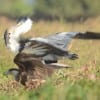 By Jim Stevenson
By Jim Stevenson
I am currently on the Gran Sabana in extreme SE Venezuela, and just showed Bruce a cock of the rock and a white bellbird. It don’t get no better than that! I am so looking forward to the GOS meetings, with the first being March 17
at the Golden Corral in Galveston (Seawall). It will be a summary of the early migrants to come, and will prepare you for the first half of the spring migration. [Mostly the stuff that breeds in the South.]
The second meeting will be in Texas City, right after FeatherFest, and will introduce the second half of the migration’s migrants. [Mostly species that breed much further north.]
This is the last call for those interested in the trip to Louisiana, including Grand Isle, the 3-day weekend after FeatherFest. I’m just looking for “interest” right now, and we’ll do the details when I get back next week.
Saw a White Hawk this morning!
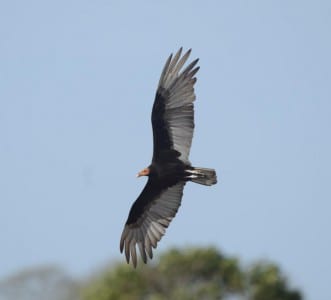
There are two yellow-headed vultures in the New World Tropics, the Lesser and Greater. I am reasonable sure this is the Greater, but they are tough! These join the very abundant Turkeys and Blacks, p lus the scarce King Vulture, to give Venezuela f ive species of them and the very rare Andean Condor (re-introduced back into Venezuela).
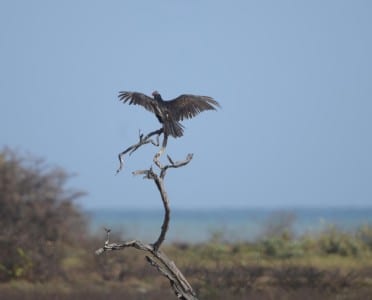
This is a lousy look at a Turkey Vulture, but I just liked the composition. That is the Caribbean, and he’s catching a few breezes along the coast (littoral) zone. He apparently slept under some companions as he has white splotches on him (or her). Turkey Vultures often feed and forage singly but Blacks are more often seen in large f locks.
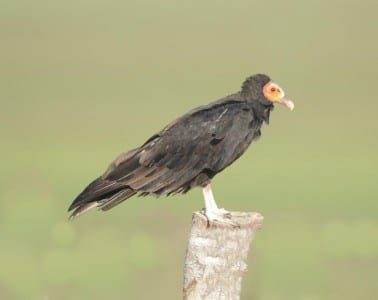
Our two terrestrial groups of scavengers are the vultures on the left (another Greater) and the caracaras (Crested) on the right. Crested Caracaras are our North American species, living in the Desert SW and Florida’s Peninsula, and breeding in my yard! To avoid getting facial feathers gross with carcass fluid, vultures have completely lost their head feathers and caracaras are well on the way.
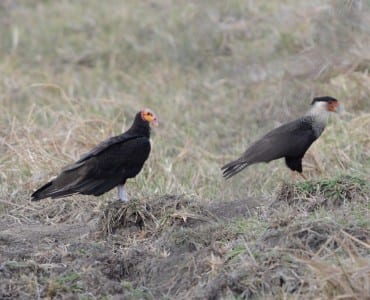
Our two terrestrial groups of scavengers are the vultures on the left (another Greater) and the caracaras (Crested) on the right. Crested Caracaras are our North American species, living in the Desert SW and Florida’s Peninsula, and breeding in my yard! To avoid getting facial feathers gross with carcass fluid, vultures have completely lost their head feathers and caracaras are well on the way.
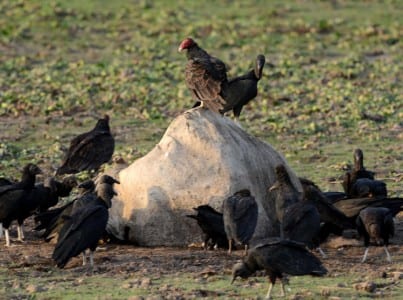
Here’s a dead cow at El Cedral that a large flock of Black Vultures has claimed, although the larger Turkeys don’t recognize their claim! Scavengers like these and gulls along our shorelines do the environment a big favor, recycling nutrients tied up in carrion, and keep down the number of diseases. The more rotten the meat, BTW, the easier they digest it!
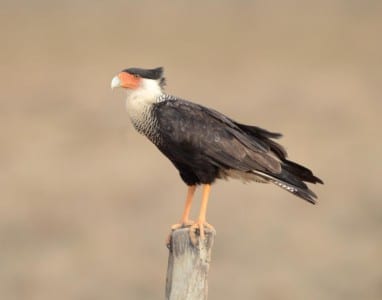
Our Crested Caracara is like an Osprey in that it has a distant resemblance to our National Bird. The black crest protects the bird from the sun’s UV rays and the white wingtips are a sure sign the bird is nonmigratory. Adults are quite black while their young are brown. They have long legs for walking on the desert floor, and I’ll bet you could think of many things those legs protect them from.
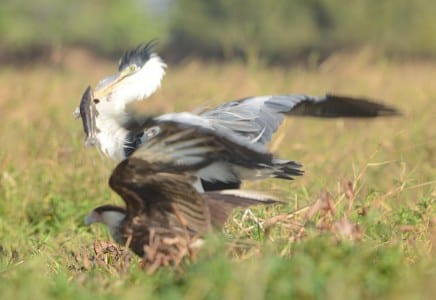
This White-necked Heron was minding his own bidness, about to enjoy a catfish, when this young caracara bolted in and eventually stole away his piscine lunch. The heron is puffing up, trying to scare off the raptor, but nothing worked. Of course, in the Llanos, there are so many fish, one loss is a small thing.
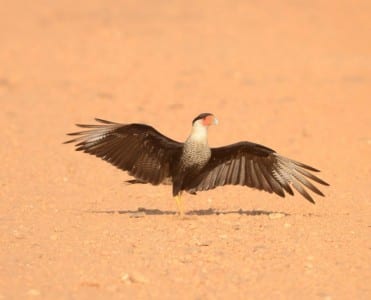
This was one of several caracaras heating up their feathers in the sun to drive out mites and such. All the black absorbs the sun’s rays and does what an egret couldn’t do. I have seen Great Blue Herons doing this, though, as well as vultures and occasionally other birds of prey. This adult has very orange facial skin. Much smaller is the Yellow-headed Caracara, a slimmer version that has just recently moved as far north as Costa Rica. They are very common in Venezuelan’s lowlands and really don’t seem to be competing much with the larger Crested. There are several other caracaras in South America, including the Carunculated of the High Andes.
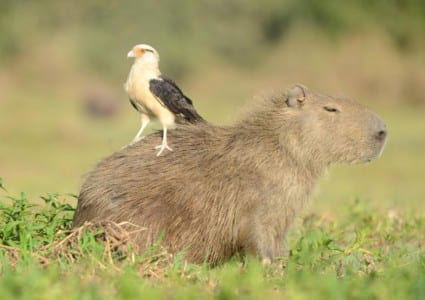
Here is a yellow-headed riding the back of a Capybara, the World’s largest rodent. These are found by the hundreds at El Cedral, with quite a few birds to ride their backs. Sitting atop the mammal gives them a better view for ground meals, and the Capybara couldn’t care less. Like labs, other male mammals have a more square snout.
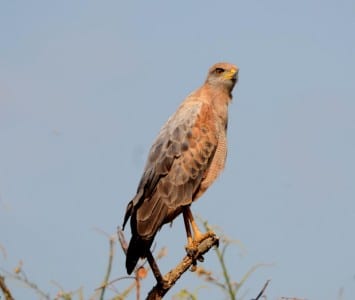
The master of the Llanos grasslands is the Savannah Hawk, a long-legged buteo that takes snakes safely with its talons. They’re very large raptors with distinct reddish-brown underparts which are mirrored in the Black-collared Hawk to come. Buteo head size and shape may be excellent field marks, like our Red-shouldereds have large, b lock heads and Red-taileds have smaller heads, disproportionately. This is a small, squarish head.
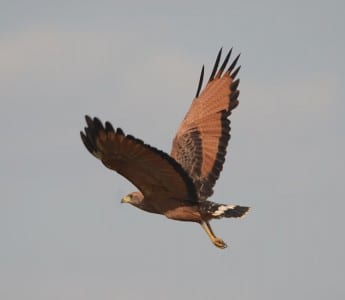
Many hawks have banded tails and these Savannahs have one wide, white band across it, like the Great Black Hawk. Some of our hawks have several black and white bands, and most have at least some. They are instrumental in IDing their species. Birds’ taxonomic characteristics like head size and shape, leg length and these broad wings are all great ID tools and teach us a lot about the birds…
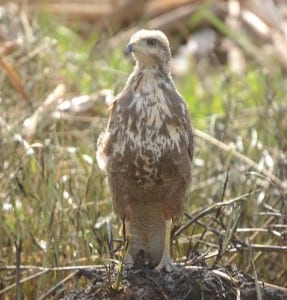
Oops, before we go to the next species, check out this immature Savannah Hawk, king of his ant hill. Young birds often lack the adult’s colors because they don’t need to dress up and they can’t go to the dance. This pattern underneath is a bit of a hodgepodge, rather than bands or streaks like many species.
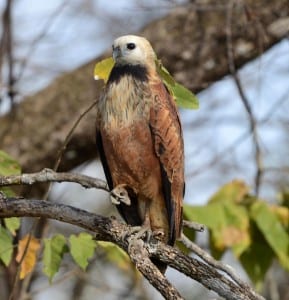
This beauty – oh! is an adult Black-collared Hawk, the wetland equivalent of the dryland Savannah Hawk. They also make a nasal aaaaang note that sounds as un-hawk-like as any call I’ve heard from a raptor. This species is a closet fish-eater, p lus what other vertebrates around the swamps and marshes it can grab.
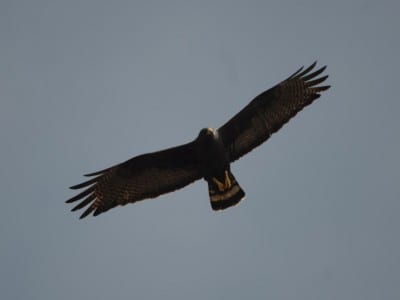
In the really dry country, like deserts, Zone-tailed Hawks soar much like Turkey Vultures and pounce on unsuspecting animals. The wings are tilted up (see next picture) and long and narrow. This bird lives over much of our Desert Southwest and thousands of miles southward to the middle of South America.
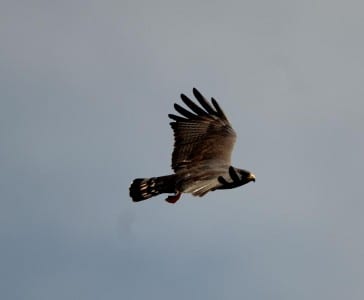
The reason their rouse works is that there are so many more TVs than zone-tails, animals just assume the dark, soaring bird is a harmless vulture, making their very last mistake. Mullerian mimicry is probably more common in nature than we know, but it’s sometimes hard to know exactly why a species has a certain color or behavior.
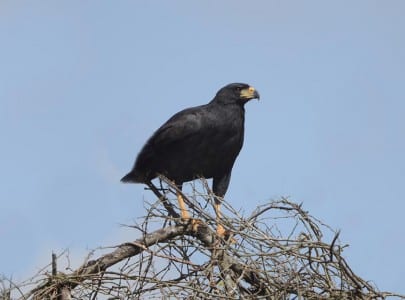
The Common Black-hawk is widespread too, and occupies many of the same deserts as zone-tails. Judging by the bill, this is a female (not a shopping joke), and her gender is always larger in raptors. BTW, there have been many changes in avian names of late, and I’m not sure but what the letter following the hyphen isn’t supposed to be in caps. But I know a guy in CA who will let me know!
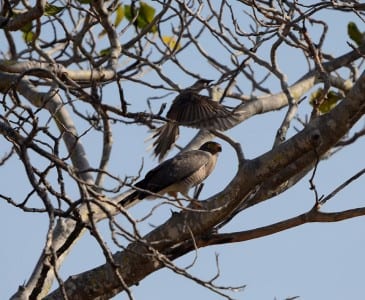
If there was ever a good name for a raptor, it’s the Roadside Hawk. This poor fella is being tormented by a Tropical Mockingbird who inwardly hopes he doesn’t rile the hawk too much. I saw a red-tail tire of crow harassment and grab one for lunch.{Please, no jokes about eating crow…} (just caws) BTW, South America has about a half-dozen mockers, compared to our one dinky bird (State Bird of about six states)."
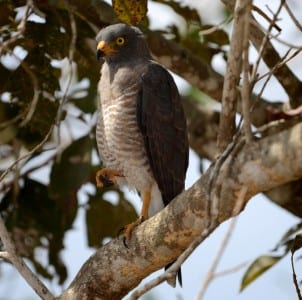
Roadside Hawks, like many birds, can look different from different angles. This bird has locked up his left leg, which frees up the right leg to groom, scratch or look gay. Many of our hawks have yellow eyes, which match their legs and cere. Adult hawks tend to have bands and juvies tend to have streaks underneath.
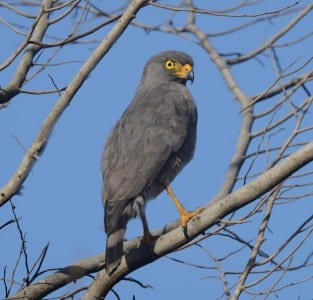
No fooling, this is another adult Roadside Hawk, but from another angle and light. This is one of the new species reported in Texas since 2000 that was new for the Country. These eat a lot of small vertebrates crossing the road and probably some carrion. Hawks have large eyes for great visual acuity but very little sense of smell.
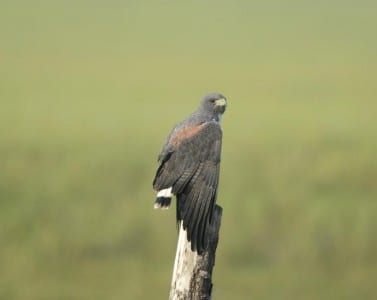
This adult White-tailed Hawk’s wings seem to have the same problem the last hawk’s legs had. Actually, he’s drying off from the morning dew, wanting to look sharp for the nearby female. This species breeds along the Texas Coast and is even seen at the Hawk Watch Tower. I did finally get it recorded in my yard after 15 years or so.
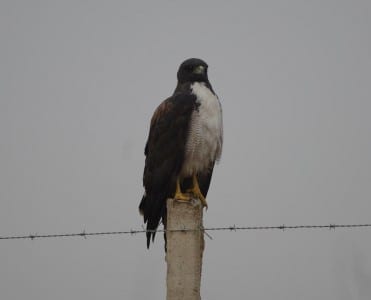
From the front, white-tails have sharp, black&white barring and necks. The reddish on the shoulder is a nice touch and they have very well-developed talons. This is another species with a huge range, and a limited migrator. I have seen people mistake them for Short-tailed Hawks, but those are rare in Texas.
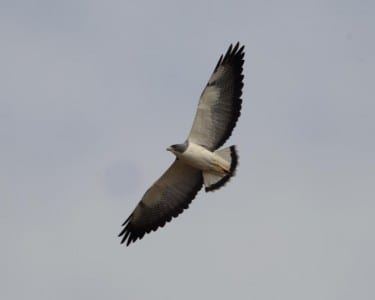
Here is an adult white-tail from below, showing the amazingly complete back-half feathers for catching the sun’s rays. The wings are also bulged for extra lift and this bird drifted off into the heavens at an amazing speed. We have these on the Texas Coast and they are fairly regular in Brazoria County.
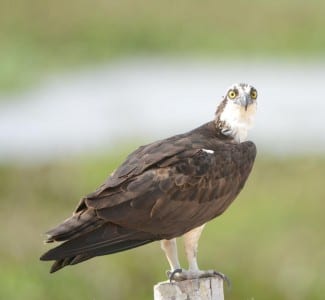
Ospreys are relatively unrelated to other raptors, and even have a different foot/toe arrangement (separate family). They are found on about every shore on the Planet and there is no pattern to their leg scales (rare, and called “holospidian”). They have a recognizable kink or crook (RTP) in their wings and a very hooked bill for tear ing up scaly fish.
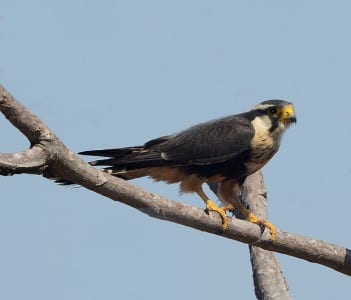
While Aplamado Falcons are rare in the Desert SW of the US, they are scattered all over Central and South America. Note the slight feet of a falcon, not heavy enough to slow down the bird, and it kills with its beak, not its feet. Most falcons have the black “helmet” to cut down on the sun’s glare, as missing the mark at over 100 mph can be fatal!
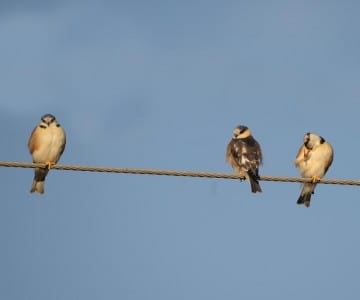
Kites are kinda built like falcons but fly slow and drop on their prey. These Pearl Kites are in a family group, the first time I’ve seen more than two together! I like the picture coz it shows you the front, the back and one making dopey gestures. These are largely insectivorous but will take lizards, small snakes and mice.
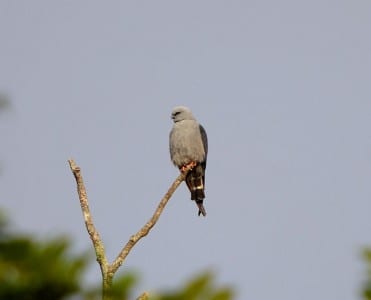
Kites are so unrelated to each other most belong to different genera. These Plumbeous Kites are very similar to our Mississippi, but are easily separated by the reddish in the wings when they fly. By April you can begin looking for Mississippis, as they return up the Texas Coast and across the Deep South.
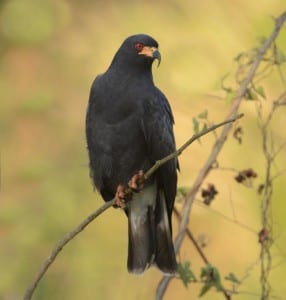
The exquisite Snail Kite is quite common in Central and South American wetlands where snails occur, and are holding their own in the Florida Peninsula. They fly a bit floppy and are black with a white base of the tail. The scientific name refers to them being social, and the beak resembling the claw of a hammer. Google it!
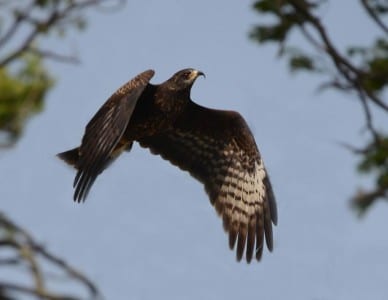
Here is the female Snail Kite (or immature male?) showing off its big, floppy wings. They pick up very large snails and must have large feet and great lift in their wings. I ain’t kidding; you should see some of them! So, how many raptors can you name where the males and females look quite different?
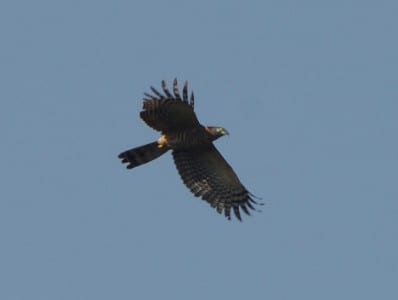
Below is the Hook-billed Kite, and other than its habit of eating land snails, and having very wide wings (and sexual dimorphism), I know very little about them. They may be seen occasionally along the Rio Grande in South Texas, especially mid-morning.
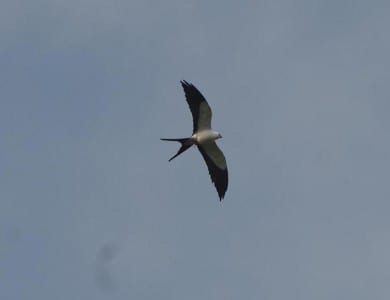
We have seen quite a few Swallow-tailed Kites streaming through from Amazonas toward the US, where they will delight birders in April to no end. Most birds with forked tails feed on the wing in windy areas, so the extra stability is helpful. These migrate up the Texas and Florida Coasts, sometimes reaching barr ier islands.
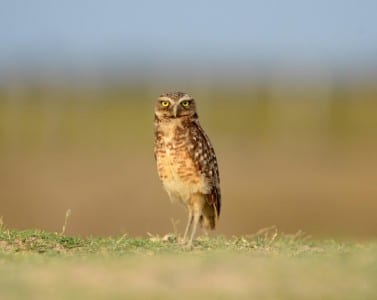
Owls are unrelated to hawks but have many similarities in their niches. And this is the Burrowing Owl, a rare denizen of dug holes in open areas. Other than their spotty distribution in the US, they have a monster range in the Americas, all the way to Peru and Chile. And yes, I was laying down shooting this bird, something Alan Murphy taught me years ago. I taught him how to be funny.

 Posted in
Posted in 























